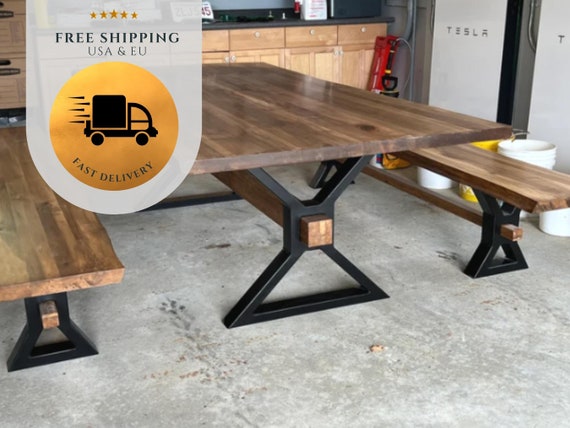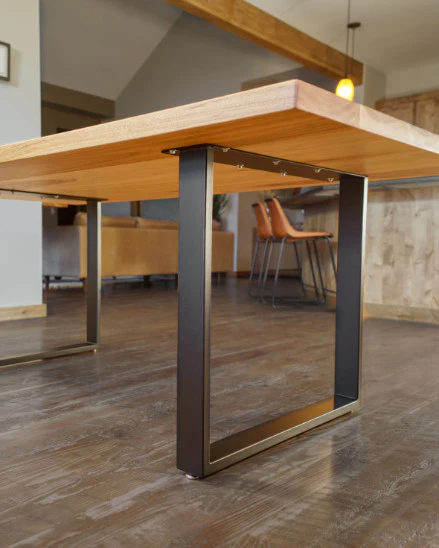Exploring Different Layouts for Dining Room Table Legs to Match Your Aesthetic
Exploring Different Layouts for Dining Room Table Legs to Match Your Aesthetic
Blog Article
A Thorough Check Out Table Leg Styles: Finding the Perfect Match
Selecting the right eating table leg style is essential for both visual allure and useful functionality. Typical 4 legs provide classic sophistication and stability, while the stand base supplies enhanced legroom and a modern-day appearance. For those with larger tables, trestle legs make certain strong support, whereas barrette legs introduce a mid-century modern ambiance with their minimalist layout. The x-shaped legs blend modern design with enhanced stability. Each of these options brings special advantages, making the selection greater than just an issue of preference. Check out further to uncover which style flawlessly complements your eating space and way of life.
Typical 4 Legs
Amongst the numerous kinds of dining table leg styles, the traditional four-leg design continues to be a classic selection for several families. Four legs offer balanced assistance, making certain the table continues to be steady and capable of bearing significant weight (dining room table legs).
From a visual point of view, the conventional four-leg design can be conveniently adjusted to different interior designs. Whether crafted from wood, metal, or a combination of products, these legs can be delicately sculpted, streamlined and minimalistic, or anything in between. Their versatility permits them to enhance both rustic and modern setups seamlessly.
Moreover, the straightforward structure of the four-leg layout promotes simplicity of motion and positioning within a room. Unlike even more complicated bases, this style decreases obstructions, providing enough legroom for diners. In recap, the standard four-leg dining table leg design marries sustaining style with functional functionality, making it a sharp choice for those looking for both form and feature in their dining furnishings.
Stand Base
Commonly celebrated for its sophisticated and space-efficient design, the stand base is a distinguished choice to the traditional four-leg arrangement in eating table leg styles. This unique base typically features a solitary central column sustaining the table top, which can vary in type, from ornately sculpted wood to smooth, modern-day metal. One of the key advantages of the pedestal base is its capacity to make the most of legroom and seating versatility. Without edge legs, diners are paid for better freedom of movement, making it an excellent choice for round and oval tables that advertise even more intimate and comprehensive gatherings.
Furthermore, the pedestal base's central support can deal with significant weight, permitting for the usage of larger tabletops, such as marble or thick wood. This strength coupled with its aesthetic flexibility makes the pedestal base a prominent option in both conventional and contemporary interior settings. It can seamlessly integrate with various design themes, from timeless style to minimal modernity. The main column itself provides a canvas for elaborate designs and imaginative expressions, including an aspect of visual interest under the table. In recap, the pedestal base combines capability snappy, making it a fine-tuned and practical alternative for varied dining environments.
Trestle Legs
Trestle legs provide a durable and ageless structure for dining tables, identified by their straight cross-bracing and sturdy assistance beams. Stemming from medieval times, this style has progressed yet kept its essential framework, making it a seasonal favorite in both typical and contemporary setups. The central trestle beam of light, frequently sustained by two or more upright messages, supplies extraordinary security, permitting bigger table lengths without the requirement for added legs.
A considerable benefit of trestle leg tables is the ample legroom look at more info they use. Unlike tables with 4 corner legs, the absence of blockages at the table's sides provides unobstructed room for chairs and diners, enhancing comfort and access. This makes trestle tables optimal for suiting larger gatherings, whether in a dining-room or a banquet hall.
The aesthetic adaptability of trestle legs is significant. Available in a range of products such as timber, steel, and composite, they can be finished to complement a variety of indoor designs. From rustic farmhouse to sleek modern designs, trestle legs can be personalized to match individual tastes. Their enduring appeal and practical benefits make trestle legs an engaging option for those looking for both design and usefulness in their table.
Barrette Legs

The charm of barrette legs hinges on their simpleness and convenience - dining room table legs. Available in a series of products, including steel and brass, they can be completed in countless shades to complement various indoor designs. Whether coupled with a rustic wooden table top or a modern glass surface area, hairpin legs effortlessly blend capability with a touch of classic charm
Sturdiness is an additional notable feature of hairpin legs. In spite of their fragile look, these legs are engineered to birth significant weight, ensuring the eating table continues to be stable and protected. Furthermore, they are fairly very easy to mount, making them a preferred selection for do it yourself enthusiasts and professional furniture makers alike.
X-Shaped Legs

Built from products such as steel, timber, or a mix of both, X-shaped legs can be customized to match various style preferences. Steel legs usually lend a sleek and industrial feel, suitable for loft-style apartment or condos and modern-day dining spaces.
Furthermore, the engineering behind X-shaped legs makes sure also weight circulation, decreasing the risk of wobbling and enhancing resilience. This makes them especially appropriate for bigger table that need extra assistance. Basically, X-shaped legs mix functional design with contemporary aesthetics, making them a timeless choice for diverse eating settings.
Verdict
A thorough understanding of table leg designs exposes the unique attributes and benefits of each design. Typical four legs supply security and classic allure, while stand bases provide legroom and a structured look. Trestle legs guarantee robust support for bigger tables, and barrette legs present a mid-century modern-day aesthetic. X-shaped legs combine contemporary More Bonuses design with boosted see this site security. Selecting the ideal leg style guarantees both practical and visual fulfillment in any type of eating room.
Report this page